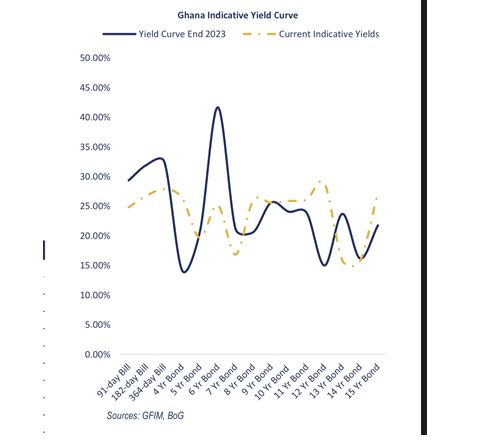By Joshua Worlasi AMLANU [email protected]
Amid tight liquidity on the local market and higher issuance targets, driven by central bank implementation of the new cash reserve ratio (CRR), investor demand at government’s weekly auctions has weakened.
Investor demand at the weekly auctions declined from an average weekly bid of GH¢5.1billion in Q1 2024 to GH¢3.7billion post-CRR hike.
This trend has continued well into the second half of the year, given that for a fourth consecutive auction week the Treasury recorded a deficit in its auctions relative to a target of GH¢6.56billion across all the bills to refinance its maturities as demand for T-bills turned weak.
At the auction’s close, investors submitted a gross bid of GH¢5.30billion while the Treasury accepted and allotted all the bids. The uptake translated into a bid-cover ratio and maturity-cover ratio of 1.00x and 0.86x respectively.
“Last week, the Treasury recorded a deficit of 19 percent relative to its target as demand for T-bills turned frail. The shortfall is unsurprising to us, given that the target was the largest so far this year,” Apakan Securities stated in its notes to investors this week.
Government’s domestic market borrowing could reach the GH¢220billion mark by close of the year as it remains barred from the international market.
Databank, in its quarterly review of the market, upped its projection for full-year government borrowing from GH¢180billion to GH¢220billion – a 22 percent increase from earlier forecasts.
T-bill yields remained unchanged, linked to the tight financing conditions. The 91-day bill inched up by 1 point to 24.83% while the 182-day and 364-day bills held steady at 26.76% and 27.86%, respectively.
The market indicates that declining yields on T-bills amid elevated inflation and a competitive option in Bank of Ghana bills continue to undermine appetite for T-bills as real returns shrink.
New CRR requirement Impact
The new CRR requirement introduced a tiered structure, allowing banks to maintain a lower CRR – essentially holding less money in reserves – if they demonstrate a higher loan-to-deposit (L/D) ratio, incentivising banks to lend more and potentially freeing-up significant funds for new loans.
Effective April 1, the policy mandates banks with loan-to-deposit ratios (LDR) exceeding 55 percent to maintain 15 percent of their deposits as reserves, while those with ratios below 40 percent must hold at least 25 percent of deposits in reserves. This change is expected to result in approximately GH¢16.2billion (US$1.2billion) flowing from banks to the Bank of Ghana (BoG).
Following successful completion of the Domestic Debt Exchange Programme (DDEP), government’s domestic market financing has been limited to the issuance of Treasury bills. During the first half of 2024, government planned to issue a gross amount of GH¢124.25billion, of which GHȼ84.84billion was for rolling over short-term maturities and GH¢39.42billion was fresh issuance to meet government’s financing requirements.
However, government could only issue GH¢107.23billion based on investor tenders totalling GH¢107.42billion. During this period, GH¢85.10billion was allocated for refinancing maturities while GH¢22.13billion supported the budget.
In Q1 2024, government planned to issue a gross amount of GH¢61.09billion, with GHȼ41.39billion allocated for rolling over short-term maturities and GH¢19.71billion for new issuance to meet financing needs. In Q2 2024, the plan was to issue GH¢63.16billion – with GHȼ43.45billion for rolling over short-term maturities and GH¢19.71billion for fresh issuance.
As the election period nears and macroeconomic indicators remain weak, investors are increasingly cautious about T-bills. The new CRR policy has tightened cedi liquidity, potentially leading to a short-term appreciation of the cedi.
Before the introduction of tiered CRR, banks’ investments in Treasury instruments had reached GH¢53.6billion by February 2024; marking a 67.6 percent year-on-year increase compared to a 36.9 percent increase in the same period of 2023. Conversely, private sector credit decreased by 14.7 percent. The tiered CRR system aims at incentivising banks to boost lending and unlock capital for economic growth.
Despite a surge in bank deposits following the DDEP, with a 25.5 percent year-on-year growth reaching GH¢224.4billion in February 2024 (an increase of GH¢45.6billion), the market remains cautious.










